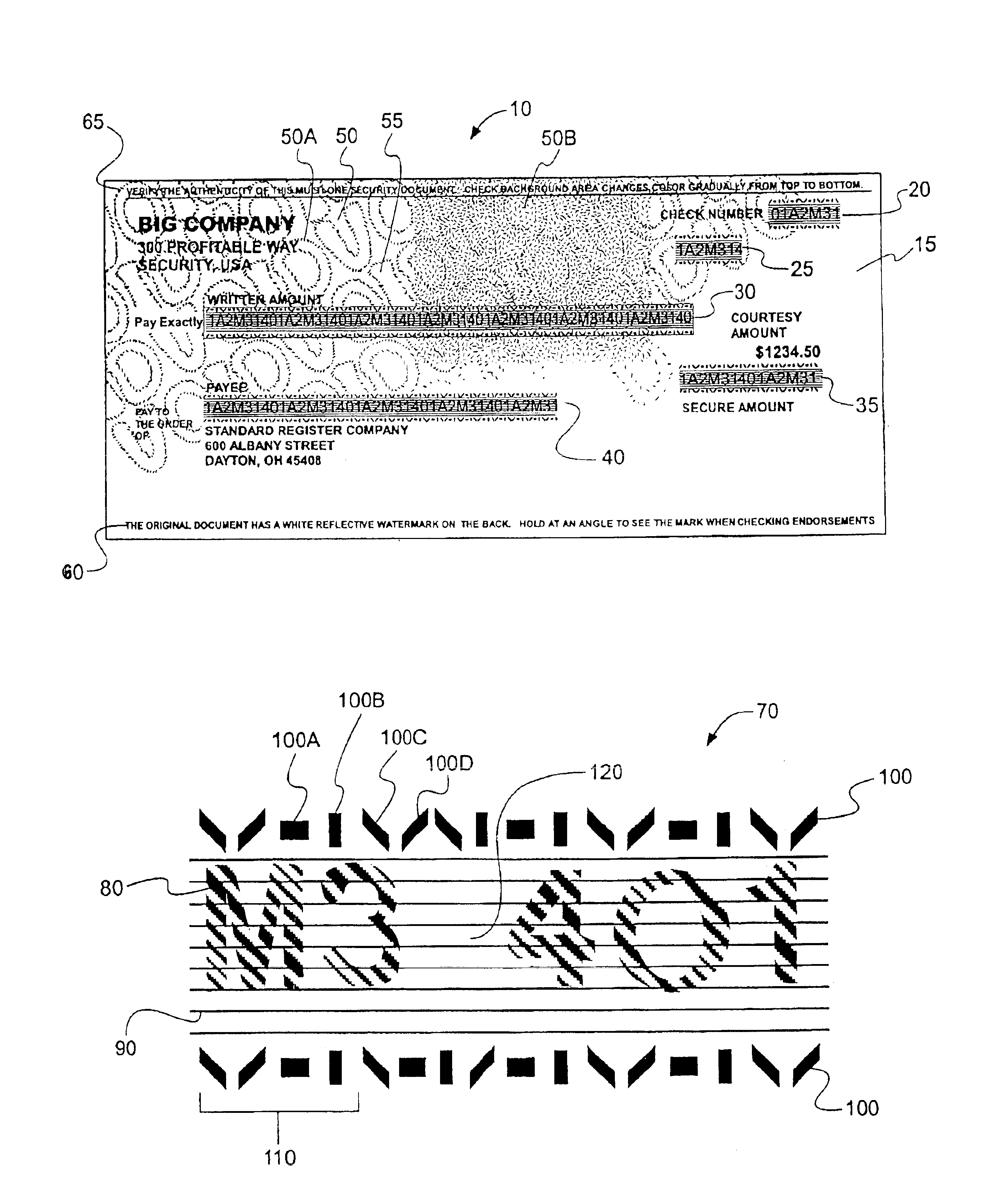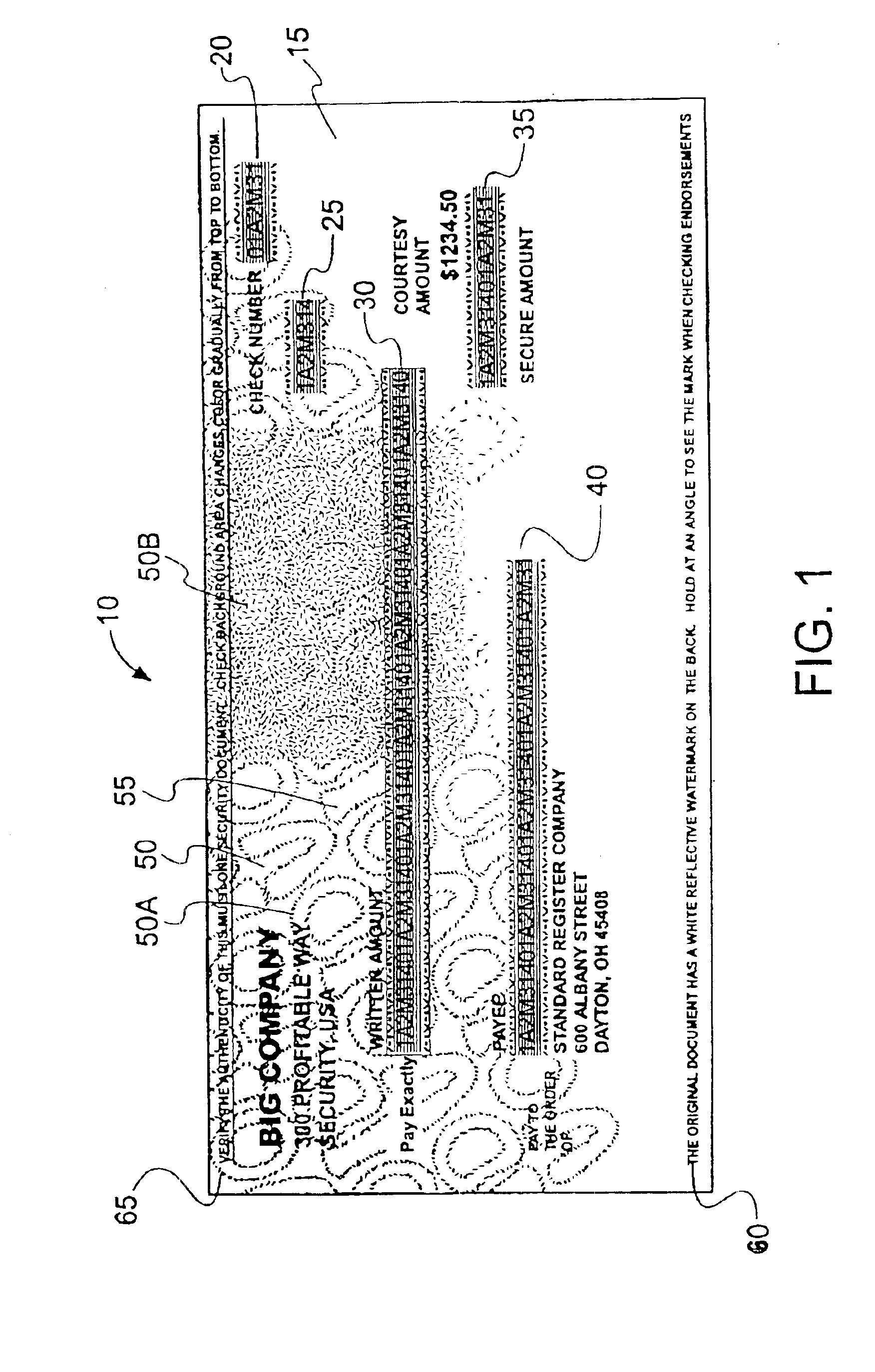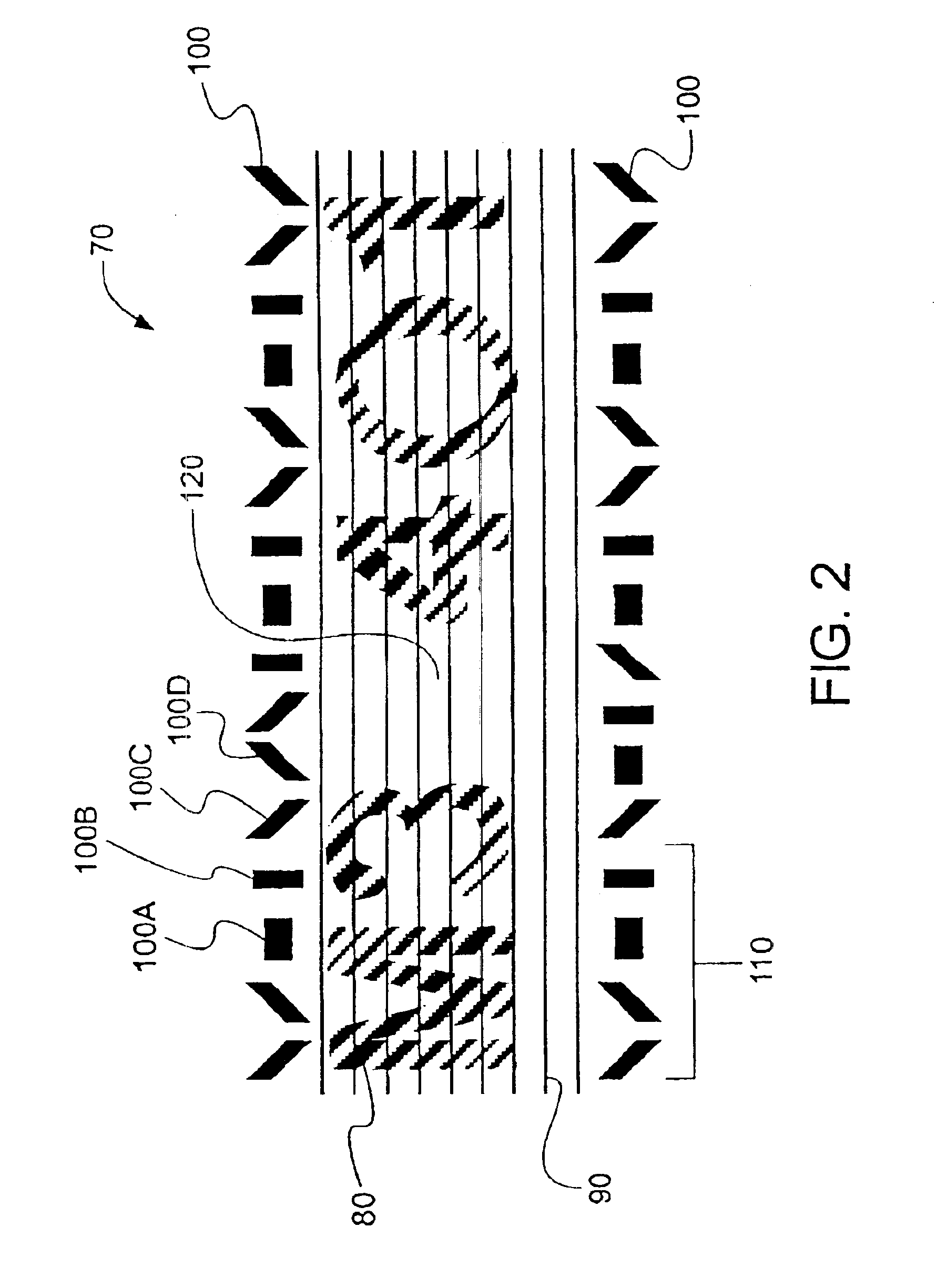[0012]Options on the font, such as the composite nature of the human-readable character and the use of spaced intercharacter lines in the pattered background, are similar to those discussed in the previous embodiment. In another option, the EDEs are arranged such that they preferably define one or more horizontally, vertically or diagonally elongate markings, all of which correspond to simple, discrete lines each with multipixel widths. Similarly, the EDEs of the security character can be invariant with, manipulated relative to or independent of each human-readable character type, where there exists numerous character types within each font. By way of example, the human-readable characters include twenty six capital letters, twenty six lowercase letters and ten numerals, among others. Thus, the
capital letter “A” refers to a particular type of
alphanumeric character, while the
capital letter “B” is a different character type. In configurations where the EDEs are capable of manipulation, two additional possibilities exist. First, the font may possess multiple representations of each character type. In such a configuration, each of the human-readable characters (i.e., 26 letters, 10 numerals and other characters) within the
library could be represented in numerous ways, where the different ways preferably include similar characters and variable elongate linear markings making up the security characters. This is especially promising in situations where the fonts are defined in
bitmap form in a font
library, where there can exist numerous variants of each character type within each font. Thus, while all of the human-readable characters of a particular type (the
capital letter “A”, for example) would look the same, the EDEs above and below would be of differing geometric patterns. These different patterns, in conjunction with a protocol that selects any one of the characters within each character type at random or by
algorithm, will, when printed, result in transactional data that gives the appearance of additional security features. This results in a simplistic approach that may confound a would-be forger by placing visually-apparent indicia of an
encoding algorithm without requiring the extra activity required of a fully operational
encryption system. Second, the EDEs could be configured to be responsive to an
encryption algorithm such that actual encryption data may be captured within each of the EDEs placed adjacent the human-readable characters. The use of an
encryption system, whether based on an existing symmetric or asymmetric key
system, proprietary or non-proprietary versions of either, or part of an entirely new hyperencryption variant, can be seamlessly coupled to the font of the present invention to offer maximum security for sensitive documents. To facilitate the printing of the
fine resolution features associated with the font, the document is preferably cooperative with a high-resolution, such as a
laser printer, thermal printer or ink-jet printer.
[0013]According to another embodiment of the present invention, an encryption-enhanced document is provided. The document includes a top surface, a plurality of transaction fields, and transactional data printed within at least one of the plurality of transaction fields. Many of the salient features of the font are similar to those discussed in the previous embodiments, with the exception that now, the encryptable font is preferably in encryption communication with an encryption algorithm such that, upon operation of the encryption algorithm on the font, at least one of the encryptable data elements is manipulated relative to its unencrypted configuration. “
Encryption communication” in the present context means that the encryption information contained within the EDEs can be sensed, interpreted and acted upon by an encryption algorithm. Preferably, the sensing of the
security information contained within the EDEs is done by optical means, such as scanning. Furthermore, the EDEs are compatible with and responsive to particular encryption schemes, whether involving symmetric approaches (such as private key-private key), or asymmetric approaches (public key-private key) or other approaches (such as one time pads or related hyperencryption, where a mutually agreed-upon random number
stream is presented in a pseudo-ethereal format). Optionally, a flag can be disposed on the document surface to indicate that at least one of the transaction fields contains printed transactional data that may be subject to encryption security features. The flag can occur in one or more of numerous locations, such as an optionally-included
magnetic ink character recognition (MICR) field that is commonly used in checks and related negotiable instruments. In addition, a key to trigger the encryption algorithm may be placed either overtly or surreptitiously on the document. The use of such an algorithm, key and encryptable EDEs, in conjunction with a
scanner or similar optical device, is capable of providing a real-time indication of the genuineness and accuracy of the transactional data, even if the document was altered with such care that the human-readable characters show no visible signs of tampering. In another option, a latent pantographic image may be disposed on the top surface. The addition of latent images (pantographs, watermarks, graded color schemes or the like) to the encryptable fonts make it more difficult for a forger to achieve a tamper-free appearance, thus enhancing the likelihood of both document and transactional genuineness.
[0014]In accordance with another embodiment of the present invention, a secure document printing
system includes an electronic font
library with a plurality of encryptable fonts, a font manipulating encryption algorithm in
signal communication with the plurality of encryptable fonts, and a printer configured to place characters generated by one or more of the fonts in tangible form on the document. In this system, the printer includes a document
receiver, a document transport mechanism configured to accept the document from the document
receiver and move the document into position to have printed transactional data placed thereon, and a print engine configured to print both human-readable and security characters to the document corresponding to an external print command (such as that coming from a computer). Configurationally, the encryptable fonts, made up of human-readable characters and security characters, are similar to those previously described. The font manipulating encryption algorithm is operably responsive to an encryption command such that, upon
receipt of the command (such as input from a keyboard, or a predefined
instruction set in a
computer program), at least the EDEs of the security characters undergo
security enhancement commensurate with the encryption algorithm. Preferably, the printer of the secure document printing system is a
laser printer to facilitate the printing of high-resolution text and related markings. The printer may optionally comprise a MICR
cartridge such that MICR characters can be added to the document, thus offering additional
transaction security by
coupling the approaches adopted herein with MICR
security enhancement. This additional feature is especially beneficial when the security document is a negotiable instrument, such as a check. The use of MICR in conjunction with the secure font has the added benefit of providing document users with compatibility features to ensure that even if the comprehensive security features made possible by the encryptable fonts of the present invention aren't immediately required to satisfy the user's secure document needs, subsequent upgrades to their systems to acquire such capability can be achieved with a smaller
quantum of
capital investment.
 Login to View More
Login to View More  Login to View More
Login to View More 


